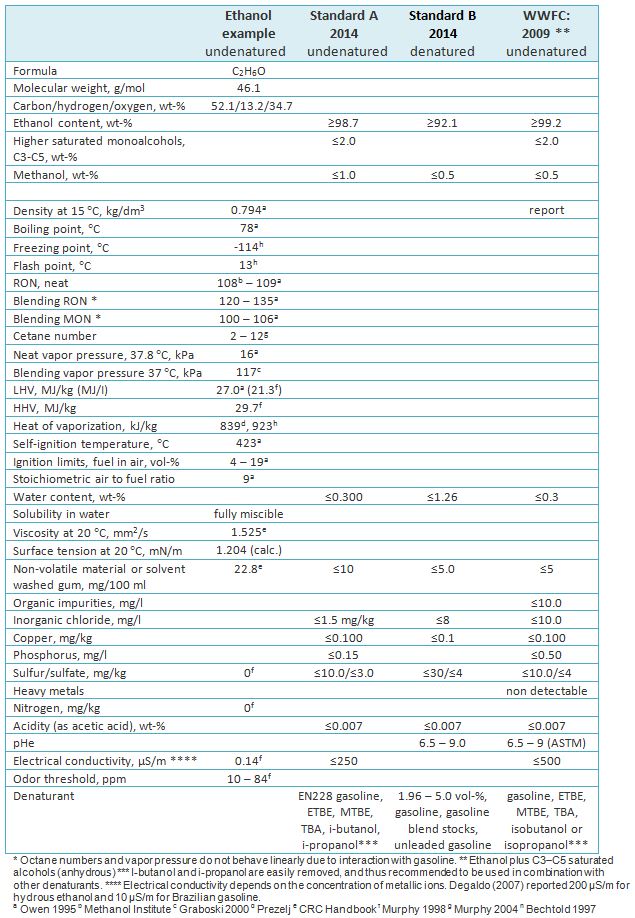Fuel properties
Ethanol is a monomolecular compound with narrow boiling range. Ethanol is aromatic-, olefin- and sulfur-free compound. Thus, ethanol may improve gasoline composition by dilution effect. Oxygen content of ethanol is 35%. About 10 vol-% ethanol represents 3.7 wt-% oxygen in gasoline. Most modern cars equipped with closed-loop control system can compensate leaning effect of gasoline containing low concentration of ethanol. Hydrogen to carbon ratio of ethanol is 3.0, whereas it is 1.85 for gasoline.
In the US, ASTM D 4814 is a specification for gasoline containing up to 10% ethanol (E15 waiver accepted for model year 2001 and newer cars). US EPA regulations allow 1 psi higher vapor pressure for blends containing 9 to 10 vol-% ethanol.
In Europe, Fuel Quality Directive 2009/30/EC allows maximum 10 vol-% ethanol in gasoline starting from 1 January 2011. Gasoline containing up to 5 vol-% of ethanol is available in European markets at least until 2013 for cars, which do not tolerate E10.
The European Committee for Standardization (CEN) has defined requirements for undenatured fuel ethanol used for low-concentration ethanol/gasoline blends (EN 15376). In the US ASTM 4806 defines requirements for denatured fuel ethanol used in blending of gasoline. Automanufacturers have defined recommendations for fuel ethanol in "WWFC Ethanol Guidelines".
Typical properties of ethanol together with the selected requirements and recommendations are shown in the following Table.
Table 1. Selected properties and requirements for anhydrous ethanol, including EN 15376 and US ASTM D 4806. Complete requirements and standards are available from respective organizations.
Octane numbers of low-molecular mass alcohols are high, and therefore they have been even used as octane boosters. Alcohols tend to increase the research octane number (RON) more than the motor octane number (MON). The blending RON of ethanol is about 120-135, and the blending MON 100-106. The sensitivity (RON-MON) is typically 8-10 units for gasoline, but 14 units for ethanol. The high octane numbers of ethanol could enable optimization of engine to increase the thermal efficiency. However, even special cars for ethanol use (FFVs) are still being a compromise to dedicated ethanol cars. Kalghatgi 2005 observed that knock sensor equipped cars performed better when using fuels with lower MON for a given RON. Ethanol increases octane numbers of the front-end distillation range of gasoline. When adjusting the octane number of ethanol/gasoline blend, octane numbers in the other distillation ranges of gasoline may need consideration.
Ethanol forms azeotropes with hydrocarbons of gasoline, which impacts volatility. In particular, the vapor pressure and distillation characteristics of ethanol/gasoline blends are non-linear. Blending vapor pressures for alcohols are significantly higher than their nominal vapor pressures. Vapor pressure of neat ethanol is low at only 16 kPa (Owen and Coley 1995). When ethanol is added into gasoline, vapor pressure increases with blending ratios of 5-10%, but then gradually declines (Figure 1). With ethanol content of some 30-50%, vapor pressure is at the same level as for gasoline without oxygenates (Environment Australia 2002, Furey 1985).
Vapor pressure of blends can be adjusted by using base fuel with low vapor pressure. If strict fuel specifications are to be met, this rules out the possibility of so-called splash-blending of ethanol. In some regions, higher vapor pressures are allowed for gasoline-ethanol blends, if they contain ethanol.
One notable point regarding the vapor pressure of ethanol blend is its tendency to increase more quickly than that of gasoline with increasing temperature. This phenomenon is illustrated in Figure 2 (Tanaka et al. 2006, referred by Wallace et al. 2009).
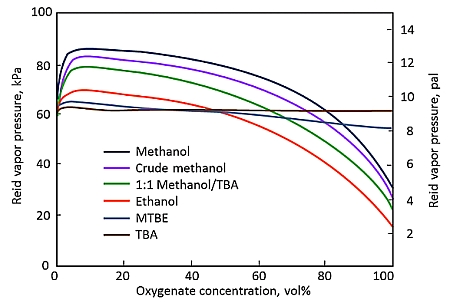
Figure 1. Vapor pressure of gasoline/oxygenate mixtures. Vapor pressure of mixtures increase at low blending ratios, but then gradually declines (Furey 1985).
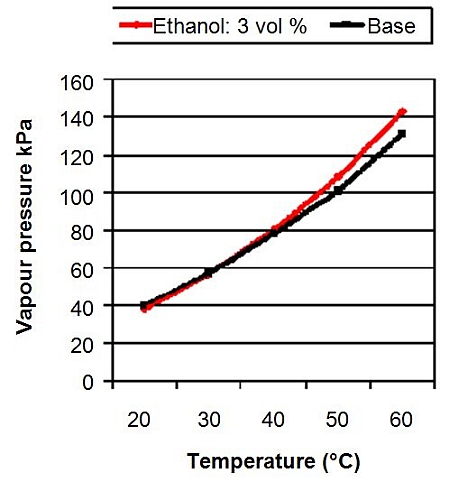
Figure 2. Vapor pressure increases more quickly for ethanol/gasoline blend than for gasoline with increasing temperature (Tanaka et al. 2006, referred to by Wallace et al. 2009).
The distillation “front-end” increases more than predicted when ethanol is blended with gasoline due to azeotropic behavior of the blend. When ethanol up to 20 vol-% is blended into a hydrocarbon gasoline, the increase in volume evaporated at 70 °C (E70) is as much as 30%. The effect of ethanol on the other parts of distillation curve is smaller. (Stradling et al. 2009). The effect of ethanol on distillation in one experimental study is shown in the Figure 3 (Aakko-Saksa et al. 2011). With 10 vol-% ethanol-containing blend, there changes in the E70 value and a flat part of distillation may be challenging (Read more of drivability).
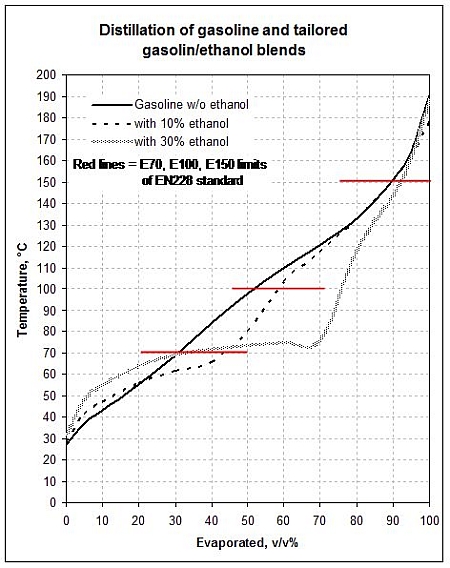
Figure 3. Example distillation curves of gasoline and tailored gasoline/ethanol blends. EN228:2008 limits for E70, E100, and E150 limits are marked as red lines (Aakko-Saksa et al. 2011).
Heat of vaporization is higher for ethanol than for gasoline, which means that more energy is required to evaporate the fuel thus lowering the engine temperatures. This can improve knock resistance as autoâ€ignition is less likely to occur with a cooler engine. Cooling of the intake air may increase engine efficiency, because higher air density allows more fuel to be injected and internal and exhaust gas heat losses are lower. (Larssen 2009).
On the other hand, high heat of vaporization aggrevates the start-up with a cold engine due to cooling effect of the air/fuel mixture. The startability limit of neat ethanol is around +12 °C (Pettersson 1994). This problem can be reduced by using at least 15% gasoline in the fuel. The high latent heat of vaporization of ethanol leads to high emissions of organic gases (Chiba et al. 2010), whereas the low combustion temperature of ethanol may lead to a reduction in engine-out NOx emissions compared with gasoline. High latent heat of evaporation may even lead to frostbite in handling of ethanol in cold weather (Bechtold 1997).
Flame temperatures of alcohols are lower than flame temperatures of aromatics, for example.
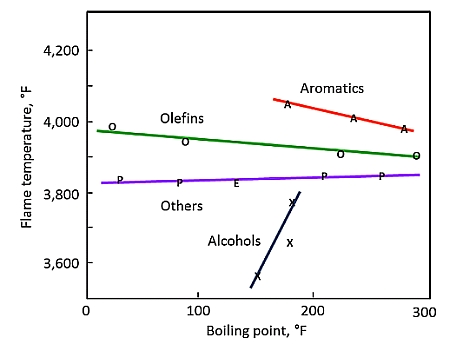
Figure 4. Flame temperature of alcohols (X), olefins (O), aromatics (A), paraffins (P), and ethers (E) (Piel and Thomas 1990).
The energy content of ethanol is lower than that of gasoline. The heating value of ethanol is around 27 MJ/kg, in volumetric terms around 21 MJ/l, which is only 65% of the volumetric energy content of gasoline. This leads to higher volumetric fuel consumption with ethanol compared to gasoline. Theoretically, increase in volumetric fuel consumption is about 3.5% when a 10% ethanol blend is compared with nonoxygenated gasoline. If the advantage of alcohols’ high octane numbers is exploited by increasing the compression ratio of the engine, energy efficiency as kilometers per energy unit of fuel (km/MJ) can be higher for alcohols than for gasoline.
Density of ethanol is 0.79 kg/l, which is slightly higher than that of gasoline. Higher density improves volumetric fuel economy to some extent.
The oxygen content of ethanol is 35%. The oxygen content of fuel determines the stoichiometric air/fuel ratio, which is 9 kg air/kg fuel for ethanol, whereas it is 14.6 kg/kg for gasoline. Closed-loop fuel control system can compensate the leaning effect of fuel, but even the modern cars can tolerate oxygenates only up to certain concentrations. This is reflected in legislation and standards of gasoline.
Ethanol may reduce the olefins and aromatics contents of the gasoline pool by a dilution effect, depending on the properties of the base gasoline.
Water tolerance and ternary phase diagrams
The storage and stability of ethanol blends are special issued due to ethanol's affinity for water and the risk of phase separation, which is harmful for cars and infrastructure. These aspects are discussed in the Chapter on compatibility. However, examples of
ternary phase diagrams are shown.
Traditionally, ternary phase diagrams are shown to present composition of three substances. Ternary phase diagram shows one-phase mixtures above the curves, and phase-separated mixture below the curves. With the higher ethanol content, the greater amount of water can be absorbed in gasoline blend without phase separation. Filho (2008) published ternary phase diagrams of ethanol, gasoline and water at different temperatures (Figure 5). Larsen et al. (2009) determined the ternary phase diagrams of ethanol with Danish winter-grade gasoline at -2°C and -25 °C (lower diagram).
Reading instruction of the ternary phase diagram is shown in Figure 6.
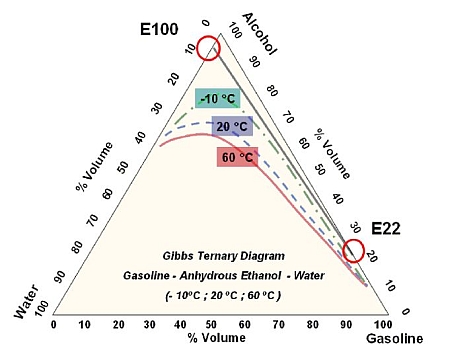
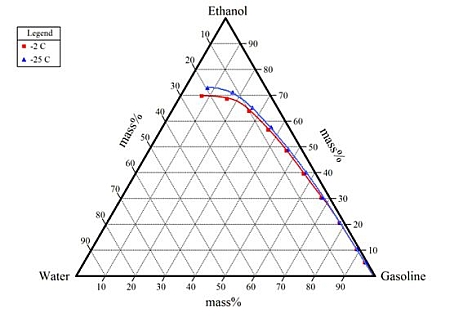
Figure 5. Ternary phase diagrams by Filho (2008) and Larsen et al. (2009).
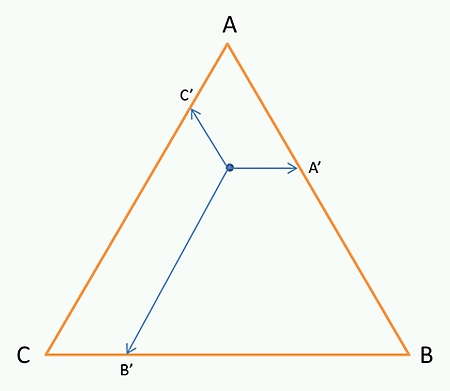
Figure 6. Reading example of ternary phase diagram.
Ethanol has limits for weak acidity (as acetic acid) and strong acidity (pHe). Weak acidity may affect long-term durability, whereas strong acidity may generate rapid corrosion. Electrical conductivity reflects for example metallic ions, such as chloride, sulfate, sodium and iron. Inorganic chlorides are corrosive towards metals. Sulfates are also corrosive, and form deposits for example in fuel injectors. Copper induces gum formation and promote injector deposits. Phosphorus may accumulate in the exhaust catalyst. (WWFC 2009).
Ethanol can be manufactured from fossil or bio-origin feedstocks. Bio-content of a blend can be based on the seller's declaration and bookkeeping, and ratio can be estimated by calculation. If required, bio-content in a fuel blend can be determined by 14C isotope methods, which are also used for example for archeological studies. CO2 in the atmosphere contains unstable 14C and stable 12C carbon isotopes in a fixed ratio, and the same ratio is found from living plants and animals. Half-life of 14C is 5730 years, which can be used to differentiate fossil and renewable carbon. Principles can be found from the standard ASTM D 6866.
High-oxygen-containing fuels, can be used in special flexible-fuel vehicles (FFV). FFVs could in principle use many type of oxygenates, but E85 is the most commonly used today. Properties of E85 are close to ethanol properties. Ignition of ethanol as such is poor and therefore at least 15 vol-% of gasoline is needed in the E85 blend, and even more in the winter-quality fuel. The low energy content of ethanol leads to high volumetric fuel consumption. The octane numbers of E85 are higher than those of gasoline. E85 is not as sensitive towards water as low level ethanol/gasoline blends, however, phase separation may occur particularly with intermediate blends in the case of mixed refueling of E85 and gasoline and at low temperatures.
A number of issues must be taken into account when infrastructure and safety aspects are considered for E85 fuel. Special vehicles, materials and distribution systems are needed. Ethanol is flammable over a wide temperature range, which requires special safety measures. Guidance on materials, electrical conductivity, safety issues and other E85 aspects are presented in the E85 Handbook (2013) by the U.S. Department of Energy. These aspects have been discussed previously.
In the U.S., E85 is specified by ASTM D5798 “Ethanol Fuel Blends for Flexible-Fuel Automotive Spark-Ignition Engines”. The properties of ethanol for E85 blending should meet ASTM D4806. Hydrocarbon blendstock may be unleaded gasoline, natural gasoline or other hydrocarbons, which meet the requirements given by ASTM D5798.
In Europe, E85 is specified by CEN 15293 “Automotive fuels – Ethanol (E85) automotive fuel – Requirements and test methods”. The EN 15293 defines four volatility classes. Ethanol for blending should comply with EN 15376.
In Canada, E85 is specified by CAN/CGSB-3.512 “Automotive ethanol fuel (E50-E85). &rdquo Four volatility classes are defined by this standard each with a specific 10% low-end design temperature for ethanol. The volatility class is based on the expected minimum temperature of use. Class I (summer) is greater than 5 °C and Class IV (winter) is less than -20 °C. The ethanol component shall meet the requirements of CAN/CGSB-3.516, Type 2 and the gasoline component shall meet the requirements of CAN/CGSB-3.5 or blendstock for oxygenate blending (BOB), that when blended with up to 10% by volume denatured fuel ethanol produces an oxygenated gasoline that complies with CAN/CGSB-3.511.
Examples of standards for the E85 fuel are shown in Table 2. At the time of this update, in Europe standard was from year 2018, while the year of last revision was 2017 in the US and 2013 in Canada.
Table 2. Examples of requirements for E85 fuel. Complete standards are available from respective organizations.
|
|
Standard 2018 |
Standard A 2017/B 2013 |
|
RON |
≥104 |
|
|
MON |
≥88 |
|
|
Density at 15 °C kg/m3 |
755 – 800 |
|
|
Oxidation stability, minutes |
≥360 |
|
|
Existent gum, mg/100 mL |
≤5 |
Washed ≤5 (A,B) Unwashed ≤20 (A) |
|
Copper strip corrosion (3 h at 50 °C) |
Class 1 |
No. 1 (B) |
|
Total acidity (as acetic acid), wt-% |
≤0.005 |
≤0.005 (A,B) |
|
pHe |
|
6.5 – 9.0 (A,B) |
|
Electrical conductivity, µS/cm |
≤1.5 |
≤5 (B) |
|
Vapor pressure |
a |
a |
|
Ethanol, vol-% |
b |
51 – 83 (A, Bb) |
|
Methanol, vol-% |
≤1.0 |
≤0.5 (A,B) |
|
Higher saturated mono-alcohols |
≤6.0 |
|
|
Ethers (C5+), vol-% |
≤11.0 |
|
|
Water content, wt-% |
≤0.4 |
≤1.0 (A,B) |
|
Inorganic chlorides, mg/kg |
≤1.2 |
≤1 (A,B) |
|
Copper |
≤0.10 mg/kg |
|
|
Phosphorus, mg/l |
≤0.15 |
≤1.3 (B) |
|
Sulfur content, mg/kg |
≤10.0 |
≤80 (A,B) |
|
Sulfate content, mg/kg |
≤2.6 |
≤4.0 (B) |
|
Appearance |
Clear and colorless |
clear (A,B) |
a Several classes. For example European 40 – 60 kPa, 60 – 90.0 kPa; ASTM 38 – 62 kPa, 48 – 65 kPa, 59 – 83 kPa, 66 – 103 kPa; Canadian, 38 – 62 kPa, 45 – 72 kPa, 62 – 86 kPa, 80 – 107 kPa.
b Several Classes, for example European 75 - 85 vol-%, 70 – 80 vol-% and 65 – 75 vol-%.
For example Canadian, 46 – 84%, 46 – 79%, 46 – 74%.
Additized ethanol properties for diesel engines
The fuel used in ethanol buses in Sweden is called Etamax D. It contains 92 % m/m of hydrated ethanol (grade 95%), 5.0 % m/m ignition improver (poly-ethylene-glycol derivative from Akzo Nobel, Beraid 3540), 2.8 % m/m denaturants (2.3 % m/m MTBE and 0.5% m/m isobutanol) and corrosion inhibitor additive. Etamax DTM fuel contains 6.4 % m/m water. (SEKAB brochure, Westman 2008). Later on, composition of Beraid additive may have changed. Today, also new commercial ignition improvers for Scania’s ethanol engine are available (Nylund et al. 2015).
In Sweden, standard SS 15 54 37 is specification for alcohols for high-speed diesel engines (Table 3). The standard does not include denaturants, ignition improvers or colorants.
Table 3. Selected properties of SEKAB's specification for Etamax DTM and Swedish SS 15 54 37 standard for ethanol used in high-speed diesel engines. Complete requirements are available from respective organizations.



